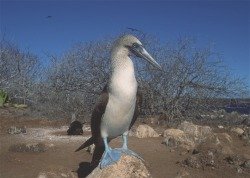Pelecaniformes
|
|
| Pelecaniformes | ||||||||
|---|---|---|---|---|---|---|---|---|
 Blue-footed Booby | ||||||||
| Scientific classification | ||||||||
| ||||||||
| Families | ||||||||
|
Pelecanidae |
The Pelecaniformes are an order of medium-sized and large waterbirds found worldwide. They are distinguished from other birds by the possession of feet with all four toes webbed (totipalmate). Most have a bare throat patch (gular patch).
They feed on fish, squid or similar marine life. Nesting is colonial, although birds are monogamous, and the young are born helpless—in contrast, for example, to many waders.
- Pelecaniformes
- Pelecanidae: pelicans. Very large birds with throat pouches in which they catch and store fish while hunting.
- Sulidae: gannets and boobies. Medium to large species which hunt by diving from the air into the sea (plunge diving). Long wings and bills, often coloured feet.
- Phalacrocoracidae: cormorants. Medium to large with hooked bills and usually black or similar dark plumage. Plumage is not fully waterproof.
- Fregatidae: frigatebirds. A group of five closely related large birds with black and white plumage, very long wings, and parasitical hunting habits. Red throat patches are inflated in display.
- Anhingidae Darters. Another small closely related group of four species, with long bills, snake-like necks and the ability to swim withe the body submerged. Plumage is not fully waterproof.
- Phaethontidae: tropicbirds. Medium-sized birds, more marine than most of the other pelecaniformes. Adults have long central tail feathers and no gular patch.
Australian-Pelicans-s.jpg
There are about 57 species in the 6 families. Recent microbiological research strongly suggests that the similarities between the Pelecaniformes are the result of convergent evolution rather than common descent, and that the group is polyphyletic. Sibley and Ahlquist's landmark DNA-DNA hybridisation studies led to them placing the families traditionally contained within the Pelecaniformes together with the grebes, cormorants, ibises and spoonbills, New World vultures, storks, penguins, albatrosses, petrels, and loons together as a sub-group within a greatly expanded order Ciconiiformes, a radical move which, although it has not been entirely accepted has been very influential.cs:Veslonozí da:Årefodede de:Ruderfüßer fr:Pelecaniformes nl:Pelecaniformes ja:ペリカン目 lt:Irklakojiniai paukščiai pt:Pelecaniformes sl:Veslonožci fi:Pelikaanilinnut sv:Pelikanfåglar zh:鹈形目
